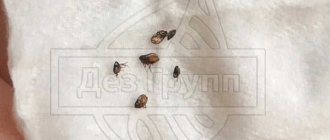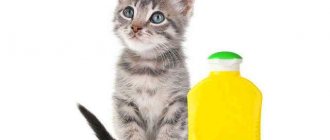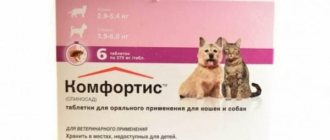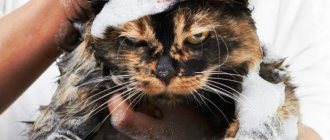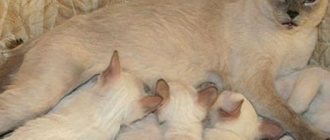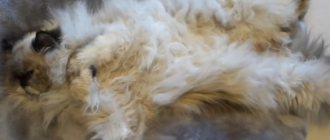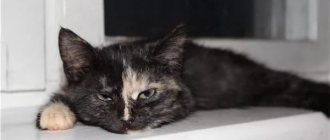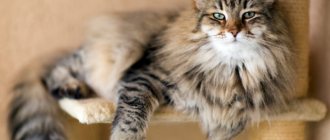There are many ways to remove fleas from a pregnant cat without harming the animal or future offspring. To eliminate parasites, you can use gentle chemicals, some folk remedies and mechanical methods of removing insects.
Fleas in pregnant cats are a very unpleasant and dangerous phenomenon.
Symptoms of fleas in a pregnant cat and methods of infection
More often, fleas appear in cats that are regularly outdoors. Parasites live for a long time without a host, but when a suitable animal passes by, they tend to jump on it. In addition, contact between pets contributes to the spread of parasites.
Fleas can also appear in cats that do not leave the apartment. Adults and their eggs can be carried by homeowners on clothes and shoes. Infection is also possible when visiting places with large concentrations of animals, incl. beauty salons, veterinary clinics, etc. Parasites multiply rapidly.
After a short time, cats develop characteristic symptoms of the presence of fleas:
- itching;
- restless behavior;
- acute desire to itch;
- red dots on the skin.
Cats experience itching and a strong desire to scratch.
When examining a cat's fur under a magnifying glass, you can identify living parasites and black lumps that are waste products of pests. Often the pet becomes irritable. In especially severe cases, severe scratching appears on the cat’s skin. Hair may fall out.
How to detect?
Fleas live on the kitten's neck and back, so a thorough examination should begin from there. Insect bites cause itching, so you should look for scratches and wounds.
You can see black lumps on the kitten's undercoat - these are traces of flea activity. To make sure they are present, you can rub the animal’s back on a white paper towel. The presence of red-brown marks will confirm fears that this is feces containing undigested blood.
The behavior of kittens may indicate the presence of parasites: the animals behave nervously, are frightened by any rustling sounds, and do not want to play. If a mother cat itches intensely and chews insects with her teeth, this also indicates the presence of fleas.
Danger of parasites
It is extremely important to remove fleas from a pregnant cat as quickly as possible, as the parasites can pose a particular danger to newborn kittens, who become infected from the mother while nursing.
Fleas are carriers of the following infectious diseases:
- brucellosis;
- rickettsiosis;
- panleukopenia;
- different types of typhus;
- anthrax;
- leprosy;
- plague;
- helminthiasis.
Fleas are carriers of diseases.
Adult cats are immune to many of these pathologies, but for kittens they are extremely dangerous. In addition, parasite bites often cause the development of allergic dermatitis in newborn animals. Constant loss of blood leads to the fact that young animals grow slowly. Signs of anemia may appear.
The animal's body weakens and becomes more susceptible to other infectious diseases. The situation is complicated by the fact that newborn kittens cannot be treated even with gentle antiparasitic agents.
The body of a young animal may not be able to withstand the toxic load, which will lead to poisoning and death.
Veterinarian advice
- Most often, the appearance of fleas on a pet is the result of a violation of basic hygiene rules.
- The flea population is enormous in size and no more than 5% of the total number parasitizes the animal’s body.
- Fleas can infest not only sleeping areas and pet carriers, but also actively breed behind baseboards and in other cracks and seams.
- According to experts, daily use of a vacuum cleaner can reduce the ectoparasite population by almost 50%.
By being patient and armed with our advice, you can alleviate the difficult situation of your pregnant cat and protect her offspring from encountering parasites.
Features of deliverance
A cat's body undergoes major changes during pregnancy. At this time, standard antiparasitic agents can create additional stress and cause deterioration in the condition of the animal and offspring.
Fleas can make your cat's condition worse.
Parasites can be poisoned with compounds that will not enter the pet’s systemic bloodstream and will not harm the process of intrauterine development of kittens. In addition, it is important that no harmful substances remain on the female’s fur after giving birth. Young animals, while searching for nipples and feeding, will ingest small doses of poison, which will lead to severe intoxication.
To treat pregnant cats, it is permissible to use only the most gentle methods possible.
Preventive actions
To avoid infection, you should minimize contact with other pets (especially in cases where there is a high probability of infection of other animals). Pregnant pets should not be taken outside: there the risk of infection is much higher, especially if there is a stray animal nearby.
Your home should be cleaned regularly. You shouldn’t limit yourself to dry; it’s important to do wet at least once a week.
Anti-flea collars can be used for prevention. It is important to consult a veterinarian first. Regular bathing using special shampoos is also recommended. You will have to bathe not only the pregnant woman herself, but also all other pets (if any). Whether it is possible to bathe a pregnant cat depends on its reaction to water. To make the procedure more comfortable, it is allowed to place an uneven rubber mat on which the paws will not slip.
The animal needs regular thorough examination. If bites are noticed and the first symptoms of parasite infection appear, measures should be taken immediately: the fewer fleas, the easier it is to deal with them.
All information posted on the site is provided in accordance with the User Agreement and is not a direct instruction to action. We strongly recommend that before using any product, you must obtain a face-to-face consultation at an accredited veterinary clinic.
Bathing and mechanical removal methods
Parasite eggs and adult fleas do not tolerate water well, so a few baths are often enough to eliminate parasites. To enhance the effect, it is permissible to use gentle shampoos. You can bathe your cat in water whose temperature should be +37°C…+39°C.
The processing process includes the following steps:
- Place a terry cloth on the bottom of a basin or sink, into which the animal can dig its claws.
- Prepare several towels in advance to dry the wool.
- Dilute the shampoo with a small amount of water.
- Place the cat in a basin and wet its fur.
- Shampoo the neck first to prevent fleas from moving onto the head, which should not be moistened.
- Lather the wool thoroughly and leave the foam for 5-7 minutes.
- Rinse the animal's fur under running water.
Bathing is an effective method of getting rid of fleas.
The method can only be used if the cat is accustomed to water procedures. If the animal previously struggled and clearly did not enjoy getting its fur wet, this method cannot be used.
The procedure will be very stressful for the cat, which will negatively affect both its health and the development of the kittens.
Brushes and combs are in most cases ineffective for flea control. These insects are jumping, so it is almost impossible to eliminate them all by combing. Some owners catch parasites with their own hands, but this method is dangerous because... may cause transmission of infections to humans.
Flea drops for kittens
Flea remedies for kittens must be selected with special care, because many of them can have an extremely negative effect not only on parasites, but also on the pets themselves.
When choosing flea drops for kittens, you need to focus on the age of the kids. In the first months of life, kittens still have too weak an immune system. Drops, which contain highly toxic substances, can cause much more harm to a pet’s health than fleas, and even lead to its death.
That is why it is advisable to use such drugs to treat a pet only after it reaches 2–3 months of age.
If the baby is breastfed, before flea treatment you need to assess the degree of its infestation. Cats lick their kittens, and this helps them to some extent get rid of parasites. However, it is precisely because of regular licking that all substances applied to the baby’s fur will inevitably end up first in the cat’s gastrointestinal tract, and then through the milk and to the kitten.
For this reason, if the number of parasites is small, it is better to rid the kitten of fleas when breastfeeding is completed.
Important! Owners should remember that it is strictly prohibited to remove fleas using insecticidal preparations for sick and weakened kittens.
What tools can be used
Not all products sold in veterinary pharmacies and pet stores can be used to eliminate fleas from the fur of a pregnant cat. However, there are still gentle drugs that, if used correctly, will not harm the animal and offspring.
Collars
It is better to consult a veterinarian before purchasing a collar. The specialist will advise the safest option. Products from the Bars and Beaphar brands are considered the least toxic. After eliminating the parasites, you need to interrupt the contact of the product containing the insecticide with the cat’s skin.
Collars are used to prevent infection.
To prevent re-infection, you can use a bio-collar soaked in essential oil:
- lavender;
- carnations;
- bergamot;
- eucalyptus, etc.
An insecticidal collar should not be put on a nursing cat, as kittens can chew it and get poisoned when playing.
Drops
Some manufacturers produce drops designed to eliminate fleas in pregnant and lactating cats. They are low-toxic and create an “umbrella” effect, destroying living parasites and preventing re-infection.
Recommended products include the following brands:
- Frontline Combo. Drops from this company contain S-methoprene and fipronil. The area between the shoulder blades is treated with the product so that the animal cannot lick it off. The drug has a prolonged effect.
- Advantage 40. The active ingredient in drops from this manufacturer is imidacloprid. The product protects both cats and kittens. The composition is applied to the withers.
- Beaphar. The drops contain an extract of the neem tree. They are effective not only against fleas, but also against ticks. This product is safe. The only contraindication for the use of the composition is the animal’s allergy to the active substance.
The drops are designed to eliminate fleas.
Spray
Some brands have already launched veterinary medications in the form of sprays that are safe for pregnant cats. These means include:
- GreenFort.
- Animal Play.
- “Phytoelite”.
- "Celandine".
These drugs contain natural active ingredients that do not enter the animal’s systemic bloodstream.
Shampoos
To eliminate fleas from the fur of a pregnant cat, shampoos based on natural ingredients are used. The following drugs have a safe composition:
- Beaphar.
- “Lugovoi”.
- “Doctor Zoo”, etc.
Shampoos are used to get rid of fleas.
Before using shampoo, you need to consult a veterinarian and clarify the safety of the drug for the animal.
Traditional methods of fighting fleas
Home remedies are not very effective in controlling fleas. They are best used to prevent the appearance of parasites.
For processing wool, compositions based on:
- wormwood;
- nettle;
- yarrow;
- lavender;
- tansy, etc.
To repel parasites, you should treat the withers with lavender or nettle essential oil. In addition, it is recommended to use homemade shampoo to combat parasites.
Wormwood is used to process wool.
Cooking steps:
- Rub 50 g of baby soap.
- Add 2 tbsp to the cereal. water.
- Simmer the mixture for 30 minutes until the soap is completely dissolved.
- Add 35 ml of yarrow infusion.
- Remove the mixture from heat and leave in a closed container for 2 hours.
You need to lather the moistened wool with the finished product. Leave the foam for 15 minutes and then rinse off under running warm water.
The treatment is also carried out with a decoction of wormwood. To prepare it, boil 25 g of crushed plant in 0.5 liters of water. The mixture is allowed to cool and the wool is moistened with it. It is advisable to treat the litter with the product.
Prevention measures
To prevent a cat from becoming infected with fleas, preventive measures are needed:
- regularly carry out wet cleaning, thoroughly vacuum furniture and carpets;
- treat animal bedding and toys with disinfectants;
- limit the interaction of cats with street animals;
- periodically bathe the cat with a special shampoo;
- You can place herbs near the pet’s place: wormwood, sage, chamomile;
- use a collar or drops for preventive purposes in the summer, when the pet is taken to the countryside or into nature.
Fleas on cats are a common and unpleasant occurrence. But don’t panic, they are easy to get rid of with the help of special means. If you use them according to the instructions and follow the advice of the veterinarian, your pet will be healthy.
What to pay attention to
Antiparasitic drops should be designed specifically for cats. Dog medications often contain other ingredients that can harm meowing pets.
Before use, you should carefully study the instructions for the drug and strictly follow its recommendations and dosages.
As a rule, you need to drip the drug onto the skin in the area of the withers or between the shoulder blades; these places are inaccessible to the cat for licking. In these areas, you need to part the animal’s fur and apply the substance directly to the skin. It must be dry and undamaged. The drops should not be rubbed in.
Do not use the drug if the cat is weakened or sick. For pregnant cats, the simultaneous use of several anti-flea products is also prohibited.


